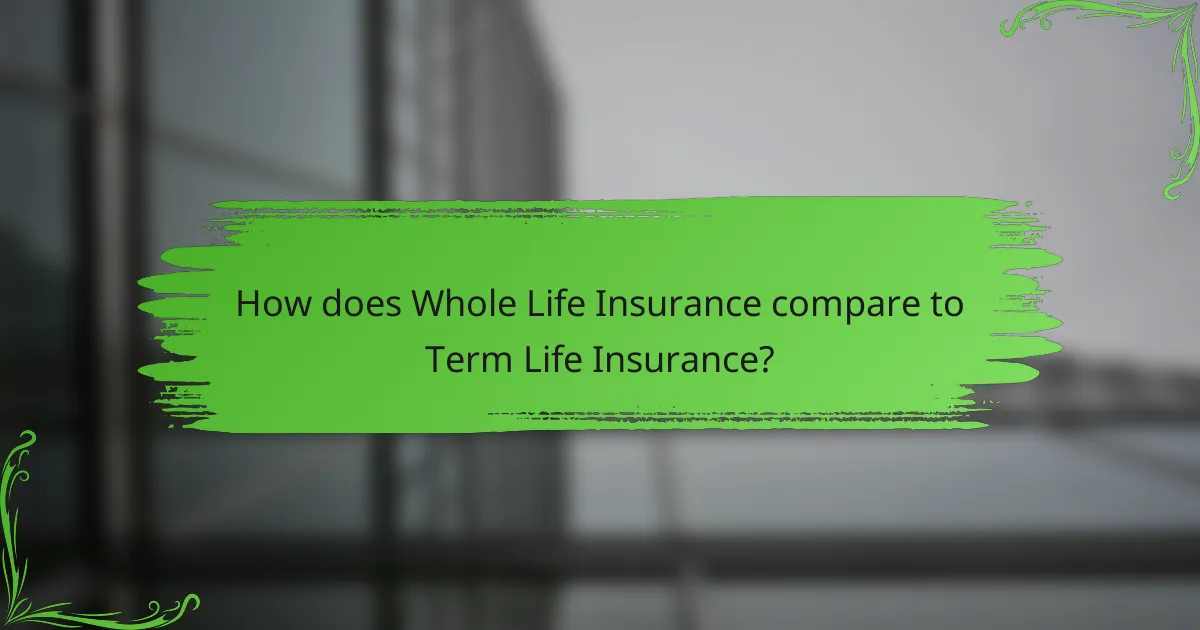Whole life insurance offers a unique combination of lifelong coverage, cash value accumulation, and fixed premiums, making it an attractive financial option for many. The cash value component grows over time, providing a safety net and potential funds for policyholders, while fixed premiums ensure predictable payments throughout the policy’s duration. This blend of features delivers both security and financial stability, allowing individuals to plan for their future with confidence.

What are the benefits of Whole Life Insurance in the UK?
Whole life insurance in the UK offers lifelong coverage, cash value accumulation, and fixed premiums, making it a reliable financial product. These features provide policyholders with security and potential savings, ensuring peace of mind throughout their lives.
Lifelong coverage
Whole life insurance guarantees coverage for the insured’s entire life, as long as premiums are paid. This means beneficiaries will receive a death benefit regardless of when the policyholder passes away. Such lifelong protection can be particularly valuable for individuals looking to secure their family’s financial future.
Consider the implications of lifelong coverage when choosing a policy. It can help cover long-term financial obligations, such as mortgages or education costs for children, providing a safety net that lasts a lifetime.
Cash value accumulation
One of the key benefits of whole life insurance is the cash value component that grows over time. A portion of each premium payment contributes to this cash value, which accumulates on a tax-deferred basis. Policyholders can access this cash value through loans or withdrawals, providing a source of funds for emergencies or investments.
The cash value typically grows at a modest rate, often around 2-4% annually, depending on the insurer. It’s important to understand that accessing cash value may reduce the death benefit, so careful consideration is necessary when utilizing this feature.
Fixed premiums
Whole life insurance features fixed premiums, meaning the amount paid remains constant throughout the life of the policy. This predictability helps individuals budget for their insurance costs without worrying about increases due to age or health changes. Fixed premiums can be particularly advantageous for long-term financial planning.
When selecting a policy, ensure that the fixed premium aligns with your financial situation. While whole life insurance tends to have higher initial premiums compared to term life insurance, the stability it offers can be beneficial in the long run. Avoid policies with hidden fees that could affect premium stability.

How does cash value accumulation work in Whole Life Insurance?
Cash value accumulation in whole life insurance refers to the growth of a savings component within the policy that builds over time. This cash value can be accessed during the policyholder’s lifetime and grows at a guaranteed rate, providing both a safety net and a potential source of funds for various needs.
Guaranteed growth
The cash value in a whole life insurance policy grows at a guaranteed rate set by the insurer. This means that regardless of market conditions, policyholders can expect a steady increase in their cash value. Typically, this growth rate is modest, often in the range of 2% to 4% annually.
In addition to the guaranteed growth, many policies also offer dividends, which can further enhance the cash value. These dividends are not guaranteed but can provide additional financial benefits based on the insurer’s performance.
Tax-deferred growth
Cash value accumulation in whole life insurance is tax-deferred, meaning that policyholders do not pay taxes on the growth until they withdraw funds. This allows the cash value to compound over time without the immediate tax burden, making it an attractive feature for long-term savings.
When funds are withdrawn, they may be subject to taxation, particularly if the amount exceeds the total premiums paid into the policy. Understanding the tax implications is crucial for effective financial planning.
Accessing cash value
Policyholders can access the cash value through loans or withdrawals. Loans against the cash value typically do not incur taxes, but they must be repaid with interest; otherwise, the outstanding loan amount will reduce the death benefit. Withdrawals, on the other hand, can be taxed if they exceed the total premiums paid.
It is advisable to carefully consider the implications of accessing cash value, as it can affect the policy’s overall performance and benefits. Regularly reviewing the policy with a financial advisor can help ensure that accessing cash value aligns with long-term financial goals.

What are the fixed premiums in Whole Life Insurance?
Fixed premiums in whole life insurance are consistent payments that policyholders make throughout the life of the policy. These premiums remain unchanged, providing financial predictability and stability over time.
Consistency in payments
With fixed premiums, policyholders can budget effectively, knowing their payment amount will not fluctuate. This consistency helps in avoiding unexpected financial burdens, making it easier to maintain coverage throughout the policy’s duration.
For example, if a whole life insurance policy has a fixed premium of $1,200 annually, the policyholder will pay this amount each year without any increases. This reliability is particularly beneficial for long-term financial planning.
Long-term financial planning
Fixed premiums contribute to long-term financial strategies by ensuring that the cost of insurance is predictable. This allows individuals to allocate funds for other investments or savings with confidence, knowing their insurance expenses are stable.
Moreover, the cash value accumulation in whole life policies can serve as a financial resource in the future. Policyholders can borrow against this cash value or withdraw funds, providing additional flexibility in managing their finances over time.

How does Whole Life Insurance compare to Term Life Insurance?
Whole life insurance provides lifelong coverage and a cash value accumulation feature, while term life insurance offers coverage for a specified period without any cash value. The choice between the two depends on individual financial goals and needs.
Coverage duration
Whole life insurance offers coverage for the insured’s entire life, as long as premiums are paid. In contrast, term life insurance is typically available for fixed periods, such as 10, 20, or 30 years. Once the term expires, the policyholder may need to renew at a higher rate or lose coverage altogether.
Cost differences
Whole life insurance generally has higher premiums compared to term life insurance due to its lifelong coverage and cash value component. Premiums for whole life policies can be several times higher than those for term policies, which are often more affordable, especially for younger individuals. For example, a healthy 30-year-old might pay a few hundred dollars annually for term coverage, while whole life premiums could reach into the thousands.
Cash value feature
One of the key benefits of whole life insurance is its cash value accumulation, which grows over time and can be accessed through loans or withdrawals. This cash value can serve as a financial resource for emergencies or retirement funding. In contrast, term life insurance does not build any cash value, meaning the policyholder receives no financial return if they outlive the term.

What factors should you consider when choosing Whole Life Insurance?
When selecting Whole Life Insurance, consider your financial goals, age and health, and the reputation of the insurance provider. These factors will help you determine the right policy that meets your needs for cash value accumulation, lifelong coverage, and fixed premiums.
Financial goals
Your financial goals play a crucial role in choosing Whole Life Insurance. Determine whether you want the policy primarily for savings, investment, or as a safety net for your beneficiaries. If cash value accumulation is a priority, look for policies with competitive interest rates and flexible premium payment options.
Consider how much you can afford to pay in premiums over the long term. Whole Life Insurance typically requires higher premiums compared to term life insurance, so ensure that your budget aligns with your financial objectives.
Age and health
Your age and health status significantly influence your Whole Life Insurance options and premiums. Generally, younger applicants secure lower premiums, as they are perceived as lower risk. If you are older or have health issues, premiums may be higher, or you may face limitations in coverage.
It’s advisable to undergo a health assessment before applying. This can help you understand your insurability and the potential costs associated with your policy. Some insurers offer guaranteed issue policies, which may not require medical exams but often come with higher premiums.
Insurance provider reputation
The reputation of the insurance provider is essential when choosing Whole Life Insurance. Research the company’s financial stability, customer service ratings, and claims settlement history. Look for insurers with strong financial ratings from agencies like A.M. Best or Standard & Poor’s.
Reading customer reviews and testimonials can provide insights into the experiences of other policyholders. A reputable provider will not only offer competitive products but also be reliable in fulfilling claims when needed.

What are the top Whole Life Insurance providers in the UK?
The leading Whole Life Insurance providers in the UK include Aviva, Legal & General, and Royal London. These companies offer policies that feature cash value accumulation, lifelong coverage, and fixed premiums, catering to various financial needs and preferences.
Aviva
Aviva is a prominent choice for Whole Life Insurance in the UK, known for its comprehensive coverage options and strong customer service. Their policies typically include a guaranteed cash value that grows over time, providing a financial safety net.
One key feature of Aviva’s Whole Life Insurance is the ability to access the cash value through loans or withdrawals, which can be beneficial in times of need. However, it’s essential to understand the implications of borrowing against your policy, as it may reduce the death benefit.
Legal & General
Legal & General offers Whole Life Insurance with a focus on affordability and flexibility. Their policies provide lifelong coverage with fixed premiums, ensuring that your beneficiaries are protected regardless of when you pass away.
With Legal & General, policyholders can expect a straightforward application process and the option to add additional benefits, such as critical illness cover. This can enhance the overall value of the policy, but it may also increase the premium costs.
Royal London
Royal London is recognized for its customer-centric approach and competitive Whole Life Insurance products. Their policies allow for cash value accumulation, which can be a significant advantage for long-term financial planning.
Royal London also provides various options for customizing your policy, including the ability to increase coverage as your financial situation changes. It’s advisable to review these options carefully to ensure they align with your long-term goals and budget.


